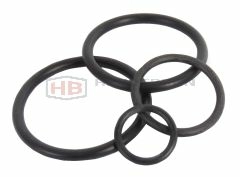- Home
- Sealing Products
- O Rings
O Rings - 171.13mm
The following materials and advanced versions of them are available in a number of colours and shore hardness. We only list most common material, sizes and colour, we have access to many more, if you are struggling to find any particular combination please do not hesitate to contact us. Listed below are material options that are available to us.
Nitrile (Buna-N), Viton® (FPM, FKM), Neoprene® (CR), EPDM, Silicone (VMQ), Kalrez®, High Nitrile, Aflas® (Tetrafluoroethylene Propylene, FEPM), Fluorosilicone (FVMQ), Polyurenthane, HNBR, SBR (Styrene-Butadiene), Natural Rubber, Polyacrylate (ACM), Butyl (IIR), PTFE, Hypalon®, Vamac® (AEM ) - Ethylene Acrylic, Perfluoroelastomers, XNBR -Carboxylated Nitrile, ECO - Epichlorohydrin Rubber, PTFE Encapsulated
What are O-rings used for?
O-rings are doughnut-shaped mechanical gaskets made from various flexible materials. They are essential in many applications to prevent the leakage of liquids or gases. Typical uses include:
- Sealing joints: O-rings are critical in systems like plumbing, hydraulics, and pneumatics to seal connections and prevent leaks.
- Automotive applications: They are used throughout fuel handling, fluid transfer systems, and air conditioning units in vehicles.
- Aerospace and marine applications: In aircraft and watercraft, O-rings help maintain system integrity and safety by preventing leaks.
- General industry: Employed in various types of machinery and equipment to seal lubricants in and keep contaminants out, ensuring smooth operation.
When would an O-ring be used?
O-rings are utilized under various conditions where a reliable seal is necessary:
- When a tight seal is needed: In machinery or systems where preventing liquid or gas leakage is vital, such as hydraulic systems or automotive fuel systems.
- Under varying pressure conditions: O-rings are designed to maintain effective seals in both low and high-pressure environments.
- In systems with extreme temperatures: Suitable material selection allows O-rings to operate effectively in both high and low temperature settings, such as in HVAC systems or engines.
Why do you need an O-ring?
O-rings are critical for several reasons:
- Leak prevention: They are key to preventing leaks that could compromise safety, efficiency, and environmental standards.
- Maintain system pressure: Especially important in hydraulic and pneumatic systems to ensure they operate correctly.
- Cost-effectiveness and simplicity: O-rings are relatively inexpensive and simple to produce and replace, making them a practical choice for many applications.
- Versatility and durability: Available in a range of materials, O-rings can be tailored to meet various environmental and operational demands, enhancing their utility across different industries.
- Inside Diameter 171.13mm Remove This Item
- 0.73mm 1 item
- 1.07mm 1 item
- 1.24mm 1 item
- 1.42mm 1 item
- 1.78mm 2 items
- 2.06mm 1 item
- 2.54mm 1 item
- 2.57mm 1 item
- 2.84mm 1 item
- 2.9mm 1 item
- 3.17mm 1 item
- 3.63mm 1 item
- 3.69mm 1 item
- 4.34mm 1 item
- 4.42mm 1 item
- 4.47mm 1 item
- 4.76mm 1 item
- 5.23mm 1 item
- 5.28mm 1 item
- 5.94mm 1 item
- 6.02mm 1 item
- 6.07mm 1 item
- 6.35mm = 1/4" 1 item
- 6.75mm 1 item
- 7.52mm 1 item
- 7.6mm 1 item
- 7.66mm 1 item
- 7.94mm 1 item
- 8.73mm 1 item
- 9.12mm 1 item
- 9.19mm 1 item
- 9.250mm 1 item
- 9.92mm 1 item
- 10.69mm 1 item
- 10.78mm 1 item
- 10.82mm 2 items
- 11.11mm 1 item
- 11.91mm 1 item
- 12.29mm 1 item
- 12.37mm 1 item
- 12.42mm 1 item
- 12.7mm = 1/2" 1 item
- 13.1mm 1 item
- 13.87mm 1 item
- 13.95mm 1 item
- 15.08mm 1 item
- 15.47mm 1 item
- 15.54mm 1 item
- 15.6mm 1 item
- 15.88mm 1 item
- 17.04mm 1 item
- 17.13mm 1 item
- 17.16mm 1 item
- 17.46mm 1 item
- 17.86mm 1 item
- 18.64mm 1 item
- 18.72mm 1 item
- 18.77mm 1 item
- 20.22mm 1 item
- 20.29mm 1 item
- 20.35mm 1 item
- 20.64mm 1 item
- 21.82mm 1 item
- 21.9mm 1 item
- 21.95mm 1 item
- 22.23mm 1 item
- 23.4mm 1 item
- 23.47mm 1 item
- 23.52mm 1 item
- 23.81mm 1 item
- 25mm 1 item
- 25.07mm 1 item
- 25.12mm 1 item
- 25.8mm 1 item
- 26mm 1 item
- 26.57mm 1 item
- 26.65mm 1 item
- 26.7mm 1 item
- 28.17mm 1 item
- 28.25mm 1 item
- 28.3mm 1 item
- 29.75mm 1 item
- 29.83mm 1 item
- 29.87mm 1 item
- 31.34mm 1 item
- 31.42mm 1 item
- 31.47mm 1 item
- 32.93mm 1 item
- 33mm 1 item
- 33.05mm 1 item
- 34.52mm 1 item
- 34.6mm 1 item
- 34.65mm 1 item
- 36.1mm 1 item
- 36.17mm 1 item
- 36.27mm 1 item
- 37.7mm 1 item
- 37.77mm 1 item
- 37.82mm 1 item
- 39.35mm 1 item
- 39.45mm 1 item
- 39.7mm 1 item
- 40.87mm 1 item
- 40.95mm 1 item
- 41mm 1 item
- 41.28mm 1 item
- 42.52mm 1 item
- 42.86mm 1 item
- 44.05mm 1 item
- 44.12mm 1 item
- 44.17mm 1 item
- 44.45mm = 1-3/4" 1 item
- 45.7mm 1 item
- 46.04mm 1 item
- 47.23mm 1 item
- 47.3mm 1 item
- 47.34mm 1 item
- 48.9mm 1 item
- 50.47mm 1 item
- 50.52mm 1 item
- 52.07mm 1 item
- 53.64mm 1 item
- 53.67mm 1 item
- 55.25mm 1 item
- 56.82mm 1 item
- 56.87mm 1 item
- 58.42mm 1 item
- 60mm 1 item
- 60.04mm 1 item
- 61.6mm 1 item
- 63.17mm 1 item
- 63.22mm 1 item
- 64.77mm 1 item
- 66.35mm 1 item
- 66.4mm 1 item
- 67.95mm 1 item
- 69.52mm 1 item
- 69.570mm 1 item
- 71.12mm 1 item
- 72.7mm 1 item
- 72.76mm 1 item
- 74.3mm 1 item
- 75.88mm 1 item
- 75.94mm 1 item
- 77.5mm 1 item
- 79mm 1 item
- 80.6mm 1 item
- 82.22mm 1 item
- 82.28mm 1 item
- 83.8mm 1 item
- 85.34mm 1 item
- 88.58mm 1 item
- 88.64mm 1 item
- 91.7mm 1 item
- 94.93mm 1 item
- 95mm 1 item
- 98.05mm 1 item
- 101.28mm 1 item
- 101.34mm 1 item
- 104.4mm 1 item
- 107.63mm 1 item
- 107.7mm 1 item
- 110.74mm 1 item
- 113.98mm 1 item
- 114mm 1 item
- 120.33mm 1 item
- 120.4mm 1 item
- 123.44mm 1 item
- 126.67mm 1 item
- 126.78mm 1 item
- 129.4mm 1 item
- 133mm 1 item
- 133.1mm 1 item
- 135.76mm 1 item
- 138.94mm 1 item
- 139.38mm 1 item
- 142.11mm 1 item
- 145.29mm 1 item
- 145.73mm 1 item
- 148.46mm 1 item
- 151.64mm 1 item
- 152.07mm 1 item
- 154.81mm 1 item
- 158mm 1 item
- 158.43mm 1 item
- 161.16mm 1 item
- 164.34mm 1 item
- 164.78mm 1 item
- 167.51mm 1 item
- 170.69mm 1 item
- 171.13mm 1 item
- 173.87mm 1 item
- 177.4mm 1 item
- 177.48mm 1 item
- 183.83mm 1 item
- 190.18mm 1 item
- 196.53mm 1 item
- 202.88mm 1 item
- 209.23mm 1 item
- 215.58mm 1 item
- 221.93mm 1 item
- 228.28mm 1 item
- 234.63mm 1 item
- 240.98mm 1 item
- 247.33mm 1 item


